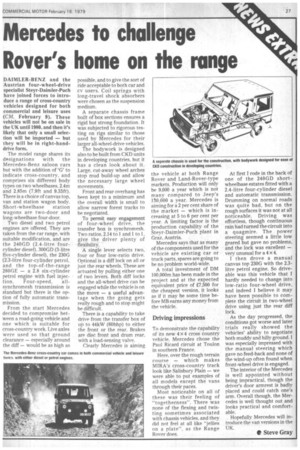Mercedes to challenge Rover's home on the range
Page 29

If you've noticed an error in this article please click here to report it so we can fix it.
DAIMLER-BENZ and the Austrian four-wheel-drive specialist Steyr-Daimler-Puch have joined forces to introduce a range of cross-country vehicles designed for both commercial and leisure uses (CM, February 9). These vehicles will not be on sale in the UK until 1980, and then it's likely that only a small selec tion will be imported — but they will be in right-handdrive form.
The model range shares its designations with the Mercedes-Benz saloon cars but with the addition of 'G' to indicate cross-country, and comprises six different body types on two wheelbases, 2.4m and 2.85m (7.9ft and 9.35ft).
There is a choice of canvas top, van and station wagon body. Short-wheelbase station wagons are two-door and long-wheelbase four-door.
Two diesel and two petrol engines are offered. They are taken from the car range, with suitable modification, and are the 240GD (2.4-litre four cylinder diesel), 300GD (3-litre five-cylinder diesel). the 230G (2.3-litre four-cylinder petrol, and the top-of-the-range 280GE — a 2.8 six-cylinder petrol engine with fuel injec tion. Four-speed, all synchromesh transmission is standard but there is the option of fully automatic transmission.
From the start Mercedes decided to compromise between a road-going vehicle and one which is suitable for cross-country work. Live axles were used so that ground clearance — especially around the diff — would be as high as possible, and to give the sort of ride acceptable to both car and cv users. Coil springs with long-travel shock absorbers were chosen as the suspension medium.
A separate chassis frame built of box sections ensures a rigid but strong foundation. It was subjected to rigorous testing on rigs similar to those used by Mercedes for their larger all-wheel-drive vehicles.
The bodywork is designed also to be built from CKD units in developing countries, but it has a clean look about it. Large, cut-away wheel arches stop mud build-up and allow the necessary large wheel movements.
Front and rear overhang has been kept to a minimum and the overall width is small to allow narrow forest tracks to be negotiated.
To permit easy engagement of four-wheel drive, the transfer box is synchromesh. Two ratios, 2.14 to 1 and 1 to I, give the driver plenty of flexibility.
A single lever selects two, four or four low-ratio drive. Optional is a diff lockon all or just the rear wheels. These are actuated by pulling either one of two levers. Both diff locks and the all-wheel drive can he engaged while the vehicle is on the move — a useful advantage when the going gets really rough and to stop might he difficult.
There is a capability to take drive from the transfer box of up to 44kW (60bhp) to either the front or the rear. Brakes are disc front and drum rear. with a load-sensing valve.
Clearly Mercedes is aiming the vehicle at both Range Rover and Land-Rover-type markets. Production will only be 9.000 a year which is not many compared to Jeep's 00.000 a year. Mercedes is aiming for a 2 per cent share of the market — which is increasing at 5 to 6 per cent per year. A limiting factor is the production capability of the Steyr-Daimler-Puch plant in Graz, Austria.
Mercedes says that as many of the components used for the vehicle are existing car or truck parts, spares are going to be no problem world-wide.
A total investment of DM 100,000m has been made in the project and at the expected equivalent price of £7,500 for the cheapest version, it looks as if it may be some time before MB earns any money from the vehicle.
Driving impressions
To demonstrate the capability of its new 4 x 4 cross country vehicle. Mercedes chose the Paul Ricard circuit at Toulon in southern France.
Here. over the rough terrain course — which makes MTRA's cross-country track look like Salisbury Plain — we were able to put examples of all models except the vans through their paces.
Most noticeable on all of these was their feeling of "togetherness". There was none of the flexing and twisting sometimes associated with chassis vehicles, and they did not feel at all like "jellies on a plate", as the Range Rover does. At first I rode in the back of one of the 240GD shortwheelbase estates fitted with a 2.4-litre four-cylinder diesel and automatic transmission. Drumming on normal roads was quite bad. but on the rough surfaces it was not at all noticeable. Driving was effortless, though continuous rain had turned the circuit into a quagmire. The . power steering seemed a little low geared but gave no problems. and the lock was excellent — very unusual for a 4 x 4.
I then drove a manual canvas top 230G with the 2.3litre petrol engine. So driveable was this vehicle that I hardly needed to change into low-ratio four-wheel drive, and indeed I believe it may have been possible to complete the circuit in two-wheel drive using just the rear diff lock.
As the day progressed. the conditions got worse and later trials really showed the vehicles' ability to negotiate both muddy and hilly ground. I was especially impressed with the manual steering which gave no feed-back and none of the wind-up often found when front-wheel drive is engaged.
The interior of the Mercedes is well appointed without being impractical, though the driver's door armrest is badly placed and could catch one's arm. Overall though, the Mercedes is well thought out and looks practical and comfortable.
Hopefully Mercedes will introduce the van versions in the UK.
• Steve Gray




















































































































